|
28 February 2009
(This PCB is no longer available, but interesting nonetheless.)
It's new and it's sweet. It's the All in One PCB, which holds two Aikido line-stage amplifiers and it includes the heater and high voltage B+ power supplies—all the same PCB. Thus, the All in One board makes building a standard-setting line stage amplifier much easier. The All in One assembled board with a chassis, volume control, selector switch, power transformer, and a fistful of RCA jacks is all that is needed. Of course, the All in One can be used for other audio purposes; for example, it could used with a DAC or even converted into a mic preamp or audio mixer or frontend to an SE power amplifier.
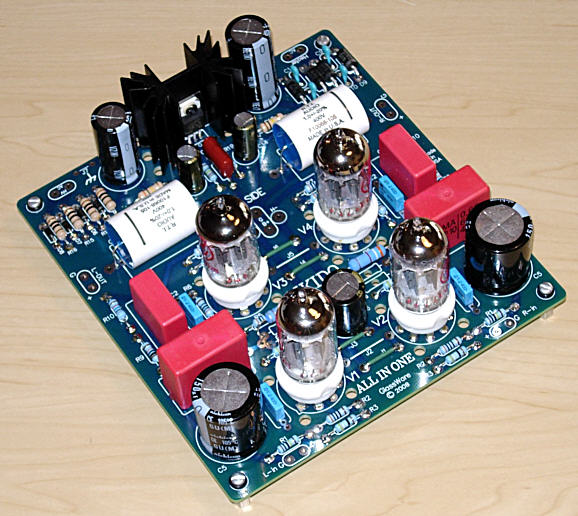
I have been sitting on these boards for two months now. I laid out this PCB last year and I have been listening to it all this year, but I only just now finished the users guide for the PCB. I built up my test unit with the aid of my six year old son; he gave me the Bud box that he had intended to build his power amplifier in and he helped with the positioning of components and the chassis drilling and metal nibbling. By the way, my son is not alone in helping his old man out, as the following e-mail make clear:
Hello John,
I ordered the 5687 Aikido and PS1 from you before Christmas. My son, Victor, who is 7 yrs old, put it together. He did all of the soldering and put most of the components on. I just had to help him with the regulators. Well, we wired it all up to the trannies on the work bench and hooked it up to a cd player and amp, and lo and behold it worked without any problems. We were careful to double check everything first, but there was absolutely no problems. With most of my other DIY projects, there is always some debugging I have to do. Your kits are so well done and easy to put together that even a 7 yr. old can do it! It sounds great, too. Now I'm ordering a case and look forward to hooking it up to my Menno Van der Veen amp and B&W 803 speakers.
More to follow when I have a chance for some serious listening and comparing of the two output caps. Beautiful boards and a fantastic value for a kit.
Best regards,
Stefan.
Does that warm the heart or what? (By the way, my son is convinced that the bigger the heatsink, the more powerful the amplifier must be. I showed him a 100W Class-D stereo amplifier that sits on a PCB that isn't bigger than 5 by 5 inches and he refuses to believe that it can put out more power than a big 11W single-ended tube amplifier.)
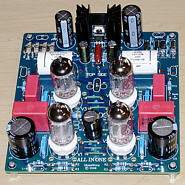 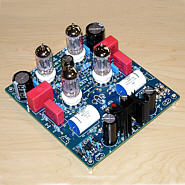 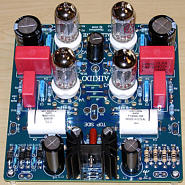
Click on thumbnail images to see close ups
On the All in One board, two power supplies reside, one for the high-voltage B+ for the tubes and a low-voltage power supply for the heaters. The high-voltage power supply uses an RC filter to smooth away ripple, while the low-voltage power supply uses a voltage regulator to provide a stable and hum-free output. The power supplies require an external power transformer with two secondary windings. I had in mind 12.6Vac for the heater power supply and between 200Vac to 250Vac for the high-voltage power supply, although the heater power supply can be setup to put out 6.3Vdc and the B+ voltage can be as low as 24V.
I am running four 12AU7s, a tube that I have long held a prejudice against, but which sound just marvelous. I gave the 12AU7s 12Vdc for their heaters and the plates get about 260V. I used two Allied open frame power transformers.
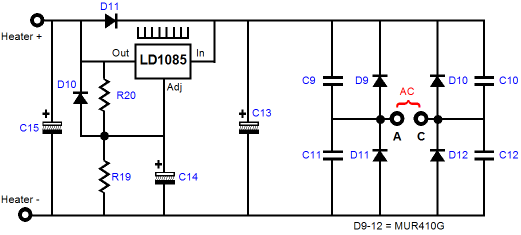
The heater regulator circuit is simple and sturdy. The low-dropout-voltage regulator, the LD1085 or LT1085, can work with a tiny voltage differential from its input tot its output. It also can deliver up to 3A. The ultra-fast rectifiers, MUR410G, offer low diode drops and smooth sound.
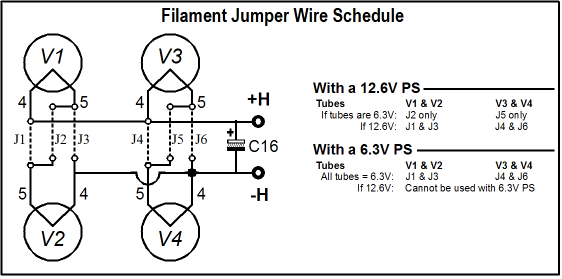
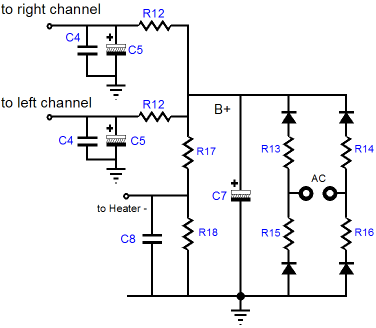
The high-voltage power supply is also quite simple. ultra-fast rectifiers, HER108, define a full-wave bridge rectifier circuit that charges up capacitor C7. Then resistors R12, which are actually made up of two resistors in parallel, R12a and R12b, puts the R in the RC filters that follow. Why two resistors? So that a greater dissipation and a larger value selection are possible; for example, treat two 10k/2W resistors as one 5k/4W resistor. Resistor heat equals I² x R (and V²/R); for example, 20mA and 5k will dissipate 2W.
The optimal B-plus voltage depends on the tubes used. For example, 6GM8s (ECC86) can be used with a low 24V power supply, while 6DJ8s work better with a 150V to 240V B+ voltage; and 6CG7s or 12AU7s, 200V to 300V. The sky is not the limit here, as the power supply capacitors and the heater-to-cathode voltage set an upward limit of about 350V for the power supply voltage after the rectifiers and about 300V at the tubes after the RC filter. Bear in mind, there is a practical limit to how large a power-supply noise signal can be nulled at the Aikido’s output. I have gotten a few e-mails from TCJers who wonder why the their Aikido setups cannot null the 25Vpk ripple on their super-tweaked power supplies. The Aikido is intended to scrub away the remaining mV of onoise on the B+, not tens of volts.
Returning to Earth, there are several goals that work against each other: we want the largest voltage-dropping resistor value possible, as it reduces the ripple appearing at the tubes’ power supply connection by making the R bigger in the RC filter; we want the lowest raw B+ voltage possible, as it will allow a larger-valued reservoir capacitor and limit the heater-to-cathode voltage; and we want the highest plate voltage possible for the tubes, as it just makes for better sound. We cannot have it all and tradeoffs must be made. A typical 250V capacitor is much more volumetrically efficient than a 400V capacitor. Thus, running a lower B-plus voltage allows us to increase greatly the capacitance in the power supply. Running lighter current allows us to maximize resistor R12’s (combined) value.
The All in One measured just fine on the test bench, but when I attached the subwoofer amplifiers, the hum was overpowering. With the sub amplifiers disconnected, everything sounded great. It drove me crazy, as I could not figure out what was causing the problem. Well, it turns out that one of the power transformers I used holds an electrostatic shield, which I attached to ground and the house ground through the three-prong power receptacle. I tried a cheater plug and the hum remained, which puzzled me greatly. After much experimenting, I disconnected the screen and the hum vanished and subs were happy. Strange. I do not know why this happened, but I am glad that I discovered it, as I could not sell the All in One boards until I found the problem.
This event will be added to my list of crazy audio problems that I never expected to encounter. One of the best crazy problems belonged to a friend of mine who complained of hum problems. After we tried everything we could, I disconnected his loudspeakers and they still hummed! We had to go under his old house to find the answer: all the house wiring was nailed to the floor boards bare, neither twisted or pipe incased, just two long runs of bare parallel wire. He had rearranged his stereo layout and he had placed his speakers over the where the parallel wires hid just an inch below under the floor and the inductor in the crossover picked up the radiated AC field like an antenna. He moved his stereo to the other end of his living room and the hum disappeared.
Pure Aikido, no frills, not even the usual safety resistors. Well, that's not quite true, as each channel does get it's own RC filter and its own Aikido power-supply-sampling circuit, C6 and R10 and R9—all of which helps.
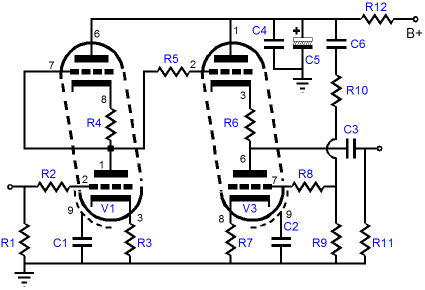
Left channel shown
As I said earlier, my son donated the chassis, to which I added the New-Old TCJ Attenuator and the Select-2 input switch and PCB. The chassis is quite small, being only 12 inches wide and 10 inches deep and 3 inches tall. The selector switch allows three input sources and I use two sets of output jacks, as I need them for my subwoofer amplifiers (or headphone amplifier). In fact, the subwoofer amplifiers are far too sensitive, so I pad their intended output jack with -12dB of fixed attenuation, which allows me to use the subwoofer amplifier's volume control more selectively.
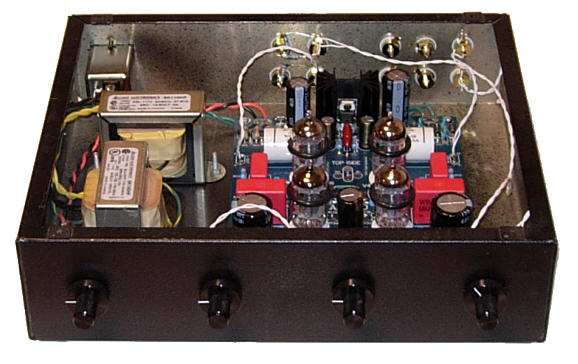
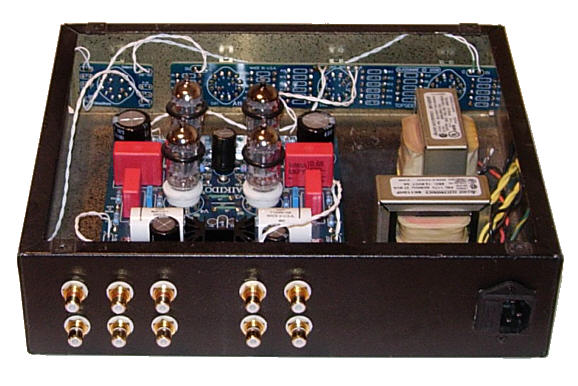
I have yet to attach all three sets of input jacks, as I have been using just one signal source since christmas. But soon...
The
All in One PCB cost $39 and is available at the GlassWare Yahoo store. A partial kit that includes everything to populate the PCB but the tubes is also available. (I hope to get more tubes soon.) I will post a PDF of the user guide soon. (I create the user guides in a technical drawing program, not a desktop publishing program, so making a PDF is a chore.)
More new kits and PCBs and back to tube testers.
//JRB
|
|
|
|
Kit User Guide PDFs
Click image to download











E-mail from GlassWare customers:
Mr Broskie,
I bought an Aikido stereo linestage kit from you some days ago, and I received it just this Monday. I have a few things to say about it. Firstly, I'm extremely impressed at the quality of what I've been sent. In fact, this is the highest quality kit I've seen anywhere, of anything. I have no idea how you managed to fit all this stuff in under what I paid for it. Second, your shipping was lightning-quick. Just more satisfaction in the bag, there. I wish everyone did business like you.
Sean H.
And
Hi John,
I received the Aikido PCB today - thank you for the first rate shipping
speed.
Wanted to let you know that this is simply the best PCB I have had in my hands, bar none. The quality is fabulous, and your documentation is superb. I know you do this because you love audio, but I think your price of $39 is a bit of a giveaway! I'm sure you could charge double and still have happy customers.
Looking forward to building the Aikido, will send some comments when I'm done!
Thank you, regards,
Gary.
9-Pin & Octal
PCBs & Kits
High-quality, double-sided, extra thick, 2-oz traces, plated-through holes, dual sets of resistor pads and pads for two coupling capacitors. Stereo and mono, octal and 9-pin printed circuit boards available.
Designed by John Broskie & Made in USA
Aikido PCBs for as little as $20.40
http://glass-ware.stores.yahoo.net/
Only $19.95
to keep track of your
tube and part collection
TCJ My-Stock DB
TCJ My-Stock DB helps you know just what you have, what it looks like, where it is, what it will be used for, and what it's worth. TCJ My-Stock DB helps you to keep track of your heap of electronic parts. More details.
List all of your parts in one DB.
Add part Images.
One-click web searches for part information.
Vertical and horizontal grids.*
Create reports as PDFs.*
Graphs added 2D/3D: pie & bar.*
More powerful DB search.
Help system added.
Editable drop-down lists for location, projects, brands, styles, vendors and more.
*User definable
For more information, please visit:
|



























